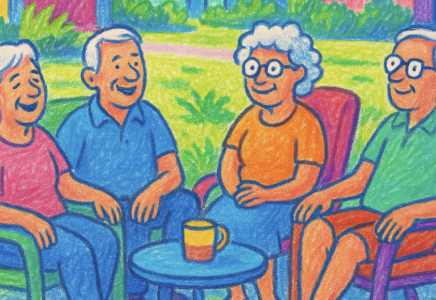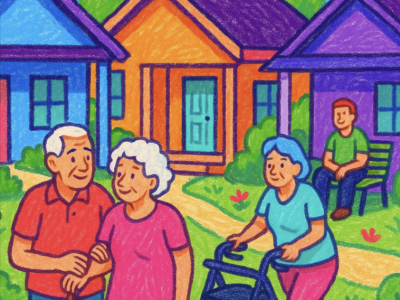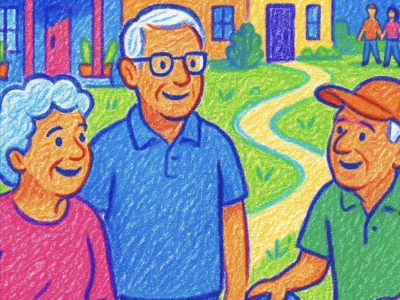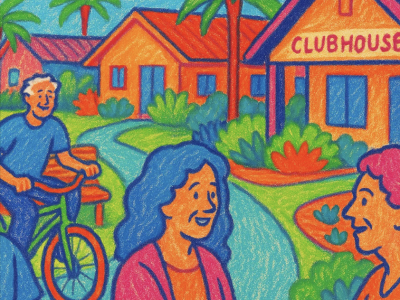Golden Years or Grand Holidays? Inside Australia’s Boom in Retirement Resort Living
- Replies 0
Retirees soaking in a heated pool, sipping coffee at a clubhouse cafe, or practicing on a private bowling green – this isn’t a luxury cruise or a country club, it’s daily life in Australia’s new wave of retirement communities.
Across the nation, developers are rolling out resort-style villages for people in their 60s, 70s, and beyond. These aren’t the sleepy retirement homes of decades past; they’re vibrant mini-resorts complete with pools, gyms, cinemas and more. And older Australians are signing up in droves. In fact, over 130,000 Australians now live in land lease or “lifestyle” communities – a sector valued around $12 billion and drawing big-name investors like Stockland and Mirvac. By 2030, one in five Australians will be 65 or older, and many of them are looking for something a bit more exciting than an armchair and daytime TV.
So what’s driving this boom in over‑60s resorts, and is it really the dream retirement lifestyle, or just a savvy sales pitch? Let’s dive in (pool pun intended).
“A lot of people think moving into a lifestyle community means slowing down, but it’s actually the opposite,” explained Mr. Coulter of GemLife, a major retirement resort operator. “Our resorts are designed to energise residents. There’s a strong social atmosphere, with shared spaces for fitness, arts, and leisure”.
Instead of just a roof over one’s head, these communities promise an active, social, and convenient lifestyle on tap. We’re talking about villages where you can do yoga in the morning, take a dip in the pool before lunch, join a craft class in the afternoon, and catch a film in a private cinema after dinner. It’s a far cry from the old stereotype of retirees quietly tending gardens (though you can do that too, if you want – many places have community veggie patches or lovely landscaping that someone else maintains while you enjoy it).
Heated indoor pools, like this one at a new retirement resort in Victoria, are part of the luxury amenities on offer. Modern retirement communities often look more like holiday resorts than aged-care facilities. Many feature indoor and outdoor swimming pools, spas and wellness centers, so residents can swim or soak year-round.
There are typically fully equipped gyms – some even with high-tech circuit equipment tailored for seniors – plus yoga studios and fitness classes for all levels. Cinemas and theaters are common, meaning you can have movie night with friends without leaving home. Bowling greens (often undercover for all-weather play) and even ten-pin bowling alleys bring a bit of nostalgic fun and friendly competition into the mix. It seems everything short of a cruise ship’s buffet is available.
Want to get your hair done or a massage? Many communities have on-site salons and wellness spas. Like to tinker or craft? You’ll find workshops, art studios and craft rooms stocked for hobbyists. And of course, there are the clubhouses and bars, the social hubs where happy hour, trivia nights or just a coffee catch-up are daily occurrences.
An indoor eight-rink bowling green at a retirement resort, providing all-weather recreation for residents. Lawn bowls has long been a favourite pastime for Aussie seniors, and the new lifestyle villages are taking it to the next level by building professional-grade, all-weather bowling facilities. This means rain, hail or shine, residents can enjoy a roll-up with friends. One new resort in Victoria features a state-of-the-art eight-rink undercover bowling green that meets professional standards – a far cry from the single outdoor rink that older retirement homes might have had.
It’s not just about sports either: there are libraries, communal gardens, barbecue areas, and even dog parks in many of these villages (yes, they’re often pet-friendly, recognizing that Fido is part of the family too). In short, the amenities on offer read like a holiday resort brochure. As one local mayor said while inaugurating a new lifestyle resort in East Gippsland, “It’s the quality and the facilities… for anyone considering moving to the region, this could be your Shangri-La”. That’s a big call, but it captures the enthusiasm surrounding these developments.
“We see residents embrace a whole new lease on life here,” noted Mr. Coulter of GemLife, highlighting how people get involved in everything from “Friday drinks in the country club to yoga and water aerobics… there’s always something happening”. For many, it’s like living permanently in a resort – you’re at home, but there’s always an activity or a neighbor to chat with just outside your door.
Social connection is a big selling point. Loneliness can be a real issue in later life, especially if one’s partner passes or friends move away. These villages try to counter that by fostering easy social interaction – impromptu chats on the bowling green, group outings, clubs and committees, etc. In fact, some communities specifically cater to demographics like single seniors, recognizing that a lot of people in this age bracket are divorced, widowed, or otherwise on their own and looking to make new friends.
Organised events (from BBQs to craft workshops to bus trips) are common. As one couple, Christine and Guy Yeldham, said after moving into a resort community, “the lifestyle – the opportunity to engage with like-minded people, and the world-class facilities” was a major attraction. They were particularly taken by how everything was at their fingertips: “Everything from the pools, the barbecues, the spa, and getting a haircut in the salon for just $17, to having the gardening and maintenance done for you, is extraordinary,” they explained. In other words, they gained community and lost a lot of the chores and worries that come with a large family home.
Another upside frequently cited is security and peace of mind. Most of these estates are gated or have security systems, offering a sense of safety. Many residents are still active travelers – some lock up and go caravanning for months knowing their home is in a secure community (with neighbours and staff around).
Others simply like the comfort of having people close by in case of emergency. It’s almost like re-creating the friendly neighborhoods of the past, but in a managed way: someone to water your plants or keep an eye out when you’re away, and a community that might rally around if someone is ill or needs help. For adult children of elderly parents, there’s some relief in knowing Mum or Dad have peers around and on-site support if needed (some villages even have a nurse on duty or visiting GP services, bridging a bit of the gap towards aged care).
Financially, the land lease model many lifestyle resorts use can be beneficial for some. In these, you purchase the home (dwelling) but lease the land from the operator, paying a weekly site fee. That sounds odd at first, but it eliminates stamp duty when you buy in, and there are typically no exit fees or deferred management fees when you leave – unlike traditional retirement villages that often charge a percentage of the resale price as an exit fee.
“We get mistaken for a retirement village, but we’re not… traditional retirement villages use a deferred fee model, which can be complex and costly. GemLife offers a completely transparent land lease model with no hidden costs,” Mr. Coulter from GemLife noted. This means residents (or their family) keep 100% of any capital gain when they sell. Additionally, because you’re paying site rent, if you’re on the Age Pension you may qualify for Commonwealth rent assistance, which helps cover those weekly fees – effectively a government subsidy of your community’s upkeep.
For many downsizers, selling the big family home can free up cash; they buy a modern home in a resort, perhaps pocket some leftover money, and then enjoy lower living costs with all the amenities included. It’s an appealing equation, especially as cost of living bites – who wouldn’t want lower bills and someone else to mow the lawn?
Perhaps the biggest draw of all: freedom and fun. After decades of working and raising families, a lot of over-60s feel they’ve “earned” a bit of luxury and leisure. These communities offer that in spades – but without isolating you from the real world. Grandkids can come stay for a weekend and use the pool or watch movies in the private cinema (trust us, grandkids think it’s awesome to visit Nana’s “resort”!).
Friends and family are generally welcome to use facilities as guests, so it can actually enhance social connections. And unlike an actual holiday resort or cruise, you’re not living out of a suitcase or limited to a week – this is home. Residents often say they feel like they’re on a permanent holiday – their address might be local, but the lifestyle feels like a getaway. As one advertisement puts it, it’s “resort living every day” for the rest of your life.
Geoff Gauci, who moved into a shiny new lifestyle village lured by low-maintenance living, later found out about hefty exit fees and even a policy that, shockingly, required a deceased resident’s family to keep paying fees until the unit was resold. “High exit fees… up to 20% of the home’s selling price after five years,” plus paying rent after death, were among the grievances that had 80 residents in one community band together to lodge a legal complaint. This isn’t the norm for all villages – many operate fairly and with transparent fees – but it underscores the need to read the fine print.
As the Housing for the Aged Action Group rightly argues, contracts should be clear and free of nasty surprises, and some of these fees “likely illegal” are being challenged. The Victorian government responded by promising stronger protections for land lease communities, like standard site agreements and possibly an ombudsman.
Even without legal drama, potential buyers should consider a few practical aspects. Location is one: these resorts are often in outer suburban or regional areas (where land is available). That can mean being further from big hospitals or that your adult kids might need to drive a bit to visit.
If you still like to go to particular city events or if you don’t drive, consider whether there’s transport or if you’ll feel isolated. Many resorts run a community bus for shopping trips and excursions, but day-to-day accessibility varies. Also, while the community on-site is strong, some people find the homogeneity a bit much – you’ll be living among people roughly the same age and often similar backgrounds.
For some, that’s wonderful (instant friends!); for others, it might feel cliquey or just strange not having younger people or a broader neighbourhood around. “If you’re social it’s great but if you’re an introvert that enjoys anonymity and personal space, it could be challenging,” one commenter noted bluntly. Everyone knows everyone’s business in a tight-knit village, which is warm and neighborly – until it’s nosy and gossip-prone. Personality fit matters.
Another consideration is cost. While these communities can be more affordable than buying a similar home in the general market (especially with no stamp duty and sometimes cheaper build costs), they’re not exactly “cheap”. Weekly site fees can range from say $180 to $250 – which is reasonable for what you get, but still a budget item. Plus, the homes themselves in the fancier resorts can cost as much as regular houses.
Premium “luxury” offerings (lakefront views, larger designs, high-end fixtures) are now common because, as GemLife observed, “demand for premium senior housing is at an all-time high”. Some buyers are happy to spend big on their final home – after all, seniors hold a large portion of Australia’s wealth and want to enjoy it. But one should be mindful not to overstretch the budget: remember, even in a resort, you need funds for daily living and future care. It’s easy to be wowed by the “emerald” lakes and golf views and sign on the dotted line; just make sure it aligns with your financial plans long-term.
Finally, consider the level of support vs independence that suits you. These lifestyle resorts are generally for independent living – they are not aged care facilities. Many do plan ahead and have partnerships or adjacent land set aside for aged care (for example, Palm Lake Resort Paynesville’s masterplan includes a co-located aged care community in the future). But if you have significant health issues or mobility problems, a place with lots of stairs and a big campus might not be ideal.
The average age in these communities might be mid-60s to early 70s upon entry – so they skew a bit younger than nursing homes. People often move in while active and then stay 10-20 years until maybe they need higher care. It’s worth asking: what happens if I become frail? Is there help available, or would I have to move again? Some villages bring in external care services or allow home care packages to be delivered, which can extend the time you can live independently there. But each model is different.
All that said, the popularity of these resort villages suggests that, for many, the pros far outweigh the cons. When issues do arise, residents are increasingly vocal in demanding improvements – and regulators are paying attention.
The industry is evolving with more transparency as it matures. As one financial columnist noted, lifestyle communities aren’t a “villain” in housing – in fact, they’re a creative solution for a lot of seniors who don’t want the old-fashioned retirement home or to burden their kids. Like any big decision, it pays to shop around, read reviews, talk to current residents and maybe rent for a short stay if possible to get a feel.
From the outside, it might look like retirees are cloistering themselves in gated theme parks for grown-ups – complete with swimming pools, woodworking sheds and cocktail hours. From the inside, residents often describe it as finding a community of friends and a fun, worry-free way of life. As with any trend, there are both enthusiastic supporters and sceptics.
Some will say, why wouldn’t you move to a place where you wake up feeling like you’re on holiday every day? Others might prefer to age in place in their long-time family home or pursue a nomadic “grey nomad” caravan lifestyle instead of settling into a village.
What’s clear is that seniors today have more choices than ever. The cookie-cutter retirement home has competition from these sparkling resorts, as well as apartment-style retirement living, and even mixed-use developments where generations live side by side. The best option really comes down to individual priorities – whether it’s being close to family, maintaining a garden, having lots of amenities, keeping costs low, or simply the vibe that feels right.
Source: 9 News Australia / Youtube.
The concept of community is at the heart of it: many seniors thrive in these villages because they’ve essentially built a new neighbourhood of peers, where it’s easy to knock on a friend’s door or join a group for a game of bowls or a trip to the shops. It harks back to a time when people knew their neighbours well, but with the added benefit of modern facilities and none of the yard work!
So, are these resort-style retirement villages the future of ageing in Australia? It certainly seems to be a growing part of it. They offer a hopeful vision: that getting older doesn’t mean giving up enjoyment or comfort – quite the opposite, it can be “the time of your life” in a purpose-built playground for grown-ups. Of course, due diligence is key to ensure the dream doesn’t sour; but countless happy residents will tell you they wish they’d made the move earlier.
In the end, whether you’re nearing retirement or already there, it’s worth thinking about what your ideal next chapter looks like. The options are out there, from quiet and simple to busy and luxurious. Would you trade your backyard and empty rooms for a community where you can join exercise classes, go for a swim, and then have a drink with friends at the club bar – all without leaving your street? Is a resort-style retirement village a dream destination for your golden years, or would you prefer something a bit more low-key?
Read more: Freedom Behind the Gates: How ‘Dementia Villages’ Are Revolutionising Aged Care in Australia
Across the nation, developers are rolling out resort-style villages for people in their 60s, 70s, and beyond. These aren’t the sleepy retirement homes of decades past; they’re vibrant mini-resorts complete with pools, gyms, cinemas and more. And older Australians are signing up in droves. In fact, over 130,000 Australians now live in land lease or “lifestyle” communities – a sector valued around $12 billion and drawing big-name investors like Stockland and Mirvac. By 2030, one in five Australians will be 65 or older, and many of them are looking for something a bit more exciting than an armchair and daytime TV.
So what’s driving this boom in over‑60s resorts, and is it really the dream retirement lifestyle, or just a savvy sales pitch? Let’s dive in (pool pun intended).
The New Face of Retirement Living
Not long ago, the phrase “retirement village” might have conjured images of modest units, quiet bingo nights and maybe a weekly bus trip to the shops. But today’s retirees – especially the cashed-up baby boomer generation – are reshaping retirement living into something far more dynamic. Developers speak of a “new breed” of villages boasting “five-star facilities including bowling alleys, 18-hole golf courses, fitness studios and architect-designed clubhouses,” to quote one industry piece. In other words, moving to a retirement community no longer means slowing down.“A lot of people think moving into a lifestyle community means slowing down, but it’s actually the opposite,” explained Mr. Coulter of GemLife, a major retirement resort operator. “Our resorts are designed to energise residents. There’s a strong social atmosphere, with shared spaces for fitness, arts, and leisure”.
Instead of just a roof over one’s head, these communities promise an active, social, and convenient lifestyle on tap. We’re talking about villages where you can do yoga in the morning, take a dip in the pool before lunch, join a craft class in the afternoon, and catch a film in a private cinema after dinner. It’s a far cry from the old stereotype of retirees quietly tending gardens (though you can do that too, if you want – many places have community veggie patches or lovely landscaping that someone else maintains while you enjoy it).
Heated indoor pools, like this one at a new retirement resort in Victoria, are part of the luxury amenities on offer. Modern retirement communities often look more like holiday resorts than aged-care facilities. Many feature indoor and outdoor swimming pools, spas and wellness centers, so residents can swim or soak year-round.
There are typically fully equipped gyms – some even with high-tech circuit equipment tailored for seniors – plus yoga studios and fitness classes for all levels. Cinemas and theaters are common, meaning you can have movie night with friends without leaving home. Bowling greens (often undercover for all-weather play) and even ten-pin bowling alleys bring a bit of nostalgic fun and friendly competition into the mix. It seems everything short of a cruise ship’s buffet is available.
Want to get your hair done or a massage? Many communities have on-site salons and wellness spas. Like to tinker or craft? You’ll find workshops, art studios and craft rooms stocked for hobbyists. And of course, there are the clubhouses and bars, the social hubs where happy hour, trivia nights or just a coffee catch-up are daily occurrences.
An indoor eight-rink bowling green at a retirement resort, providing all-weather recreation for residents. Lawn bowls has long been a favourite pastime for Aussie seniors, and the new lifestyle villages are taking it to the next level by building professional-grade, all-weather bowling facilities. This means rain, hail or shine, residents can enjoy a roll-up with friends. One new resort in Victoria features a state-of-the-art eight-rink undercover bowling green that meets professional standards – a far cry from the single outdoor rink that older retirement homes might have had.
It’s not just about sports either: there are libraries, communal gardens, barbecue areas, and even dog parks in many of these villages (yes, they’re often pet-friendly, recognizing that Fido is part of the family too). In short, the amenities on offer read like a holiday resort brochure. As one local mayor said while inaugurating a new lifestyle resort in East Gippsland, “It’s the quality and the facilities… for anyone considering moving to the region, this could be your Shangri-La”. That’s a big call, but it captures the enthusiasm surrounding these developments.
Sprouting Up Nationwide: New Resorts from Coast to Coast
So where are these retirement resorts and villages popping up? The short answer: everywhere. What began some years ago in Queensland and coastal New South Wales has now spread across the whole country. Here’s a quick look at just a few of the new communities making waves in each state:- Queensland: The Sunshine State has embraced the concept fully. In Bundaberg, for example, the upcoming Coral Cove Ocean Estate will deliver up to 1,600 homes around a popular golf course, complete with a new clubhouse, hotel and even holiday accommodation for visitors. On the Sunshine Coast and Gold Coast, companies like Stockland (with its Halcyon communities) and GemLife have been expanding rapidly. Stockland just launched one of its largest over-50s resorts, Halcyon Bayside, boasting luxury facilities by the bay. GemLife – now an ASX-listed powerhouse – has multiple resorts across SE QLD and is planning a new $428 million community at Elimbah in Moreton Bay, north of Brisbane. Even regional areas like Cairns are joining in; the Botanica lifestyle resort near Cairns is the first of its kind in that area, offering tropical resort living for locals who don’t want to leave the Far North.
- New South Wales: In NSW, both coastal hideaways and city outskirts are getting attention. On the Mid-North Coast, the Harrington Waters community for over-55s offers a close-knit seaside lifestyle with its own marina, shopping village and a nine-hole golf course on site. Meanwhile, in western Sydney, a major $160 million project was just approved to build a retirement community at the Cumberland Country Golf Club in Greystanes, incorporating 234 independent living units alongside the reconfigured golf course and wellness amenities like a gym, indoor pool and cinema. Sydney’s outskirts have several such developments in the works as people look to downsize out of the city hustle. Even rural towns are not left out – regions like the Mid North Coast and Hunter Valley are seeing lifestyle resort proposals as retirees seek a tree-change or sea-change with all the perks.
- Victoria: Victoria is experiencing a boom in land-lease communities (the common model for these lifestyle resorts). A new brand called Springtree has launched with two sites along the Murray River – one in Cobram and another in Yarrawonga – aiming for a portfolio of 10+ over-60s resorts worth half a billion dollars. These resorts offer brand new homes (2-3 bedrooms) and a suite of facilities, without the hefty exit fees of traditional retirement villages. “More and more people are discovering the country charm of the region… and the ageing population has increased demand for low-maintenance lifestyle communities,” said David Laing, co-founder of Springtreelished players like Palm Lake Resort are expanding too – their new community in Paynesville (Gippsland) will have 195 homes around a just-opened $20 million country club facility. Melbourne isn’t missing out either: several high-end apartment-style retirement living projects are underway, and villages in scenic spots like the Mornington Peninsula continue to upgrade with resort-like features to attract younger retirees.
- South Australia: SA might have been a bit slower on the uptake, but it’s catching up. Adelaide now boasts Flagstaff Hill lifestyle estate, the state’s first fully integrated golf course and retirement community. Stage 1 delivered modern villas and apartments overlooking the course, and Stage 2 is under construction, complete with a new clubhouse, restaurant, pool and cinema for residents. In the Barossa Valley, even the community-run Barossa Village is expanding with new residences to cater for growing demand. It seems even wine country wants in on the action – who wouldn’t want to retire among the vineyards with a five-star clubhouse to enjoy a local Shiraz in?
- Western Australia & Others: Over-60s resorts are rising in the west as well. Around Perth, new lifestyle communities like Providence’s Wattle Grove offer gated resort living with solar-equipped homes, clubhouses and more South of Perth, areas like Dunsborough and Mandurah have seen luxury lifestyle village projects, appealing to those who want a coastal retirement without leaving WA. Even the Northern Territory is exploring the model on a smaller scale, and in Tasmania, a new over-60s resort in New Norfolk (outside Hobart) is providing a “vibrant, lavish” community in a historic town. In short, from the tropics to Tassie, and from city suburbs to country towns, there’s likely a new retirement resort either recently opened or coming soon near you.
Life in a “Lifestyle” Resort: The Upsides
What’s the actual day-to-day life like inside these communities? By most accounts, pretty fun and social. Residents often describe a strong sense of community and newfound freedom. With maintenance and yard-work largely taken care of by the village management, residents are free to spend their days on hobbies, recreation or just relaxing.“We see residents embrace a whole new lease on life here,” noted Mr. Coulter of GemLife, highlighting how people get involved in everything from “Friday drinks in the country club to yoga and water aerobics… there’s always something happening”. For many, it’s like living permanently in a resort – you’re at home, but there’s always an activity or a neighbor to chat with just outside your door.
Social connection is a big selling point. Loneliness can be a real issue in later life, especially if one’s partner passes or friends move away. These villages try to counter that by fostering easy social interaction – impromptu chats on the bowling green, group outings, clubs and committees, etc. In fact, some communities specifically cater to demographics like single seniors, recognizing that a lot of people in this age bracket are divorced, widowed, or otherwise on their own and looking to make new friends.
Organised events (from BBQs to craft workshops to bus trips) are common. As one couple, Christine and Guy Yeldham, said after moving into a resort community, “the lifestyle – the opportunity to engage with like-minded people, and the world-class facilities” was a major attraction. They were particularly taken by how everything was at their fingertips: “Everything from the pools, the barbecues, the spa, and getting a haircut in the salon for just $17, to having the gardening and maintenance done for you, is extraordinary,” they explained. In other words, they gained community and lost a lot of the chores and worries that come with a large family home.
Another upside frequently cited is security and peace of mind. Most of these estates are gated or have security systems, offering a sense of safety. Many residents are still active travelers – some lock up and go caravanning for months knowing their home is in a secure community (with neighbours and staff around).
Others simply like the comfort of having people close by in case of emergency. It’s almost like re-creating the friendly neighborhoods of the past, but in a managed way: someone to water your plants or keep an eye out when you’re away, and a community that might rally around if someone is ill or needs help. For adult children of elderly parents, there’s some relief in knowing Mum or Dad have peers around and on-site support if needed (some villages even have a nurse on duty or visiting GP services, bridging a bit of the gap towards aged care).
Financially, the land lease model many lifestyle resorts use can be beneficial for some. In these, you purchase the home (dwelling) but lease the land from the operator, paying a weekly site fee. That sounds odd at first, but it eliminates stamp duty when you buy in, and there are typically no exit fees or deferred management fees when you leave – unlike traditional retirement villages that often charge a percentage of the resale price as an exit fee.
For many downsizers, selling the big family home can free up cash; they buy a modern home in a resort, perhaps pocket some leftover money, and then enjoy lower living costs with all the amenities included. It’s an appealing equation, especially as cost of living bites – who wouldn’t want lower bills and someone else to mow the lawn?
Perhaps the biggest draw of all: freedom and fun. After decades of working and raising families, a lot of over-60s feel they’ve “earned” a bit of luxury and leisure. These communities offer that in spades – but without isolating you from the real world. Grandkids can come stay for a weekend and use the pool or watch movies in the private cinema (trust us, grandkids think it’s awesome to visit Nana’s “resort”!).
Friends and family are generally welcome to use facilities as guests, so it can actually enhance social connections. And unlike an actual holiday resort or cruise, you’re not living out of a suitcase or limited to a week – this is home. Residents often say they feel like they’re on a permanent holiday – their address might be local, but the lifestyle feels like a getaway. As one advertisement puts it, it’s “resort living every day” for the rest of your life.
Not All Sunshine and Sausage Sizzles: The Fine Print
With all the glossy brochures and happy testimonials, it’s easy to get swept up in the resort retirement dream. But are there any downsides or catches behind the scenes? It’s important to acknowledge that resort-style living isn’t for everyone, and some communities have had controversy. One notable case unfolded in 2024 when an ABC investigation (on the 7.30 program) shone a light on certain business practices in the industry. The spotlight was on a company in Victoria where residents discovered clauses that turned their dream into what one retired policeman described as a “financial prison”.Geoff Gauci, who moved into a shiny new lifestyle village lured by low-maintenance living, later found out about hefty exit fees and even a policy that, shockingly, required a deceased resident’s family to keep paying fees until the unit was resold. “High exit fees… up to 20% of the home’s selling price after five years,” plus paying rent after death, were among the grievances that had 80 residents in one community band together to lodge a legal complaint. This isn’t the norm for all villages – many operate fairly and with transparent fees – but it underscores the need to read the fine print.
As the Housing for the Aged Action Group rightly argues, contracts should be clear and free of nasty surprises, and some of these fees “likely illegal” are being challenged. The Victorian government responded by promising stronger protections for land lease communities, like standard site agreements and possibly an ombudsman.
Even without legal drama, potential buyers should consider a few practical aspects. Location is one: these resorts are often in outer suburban or regional areas (where land is available). That can mean being further from big hospitals or that your adult kids might need to drive a bit to visit.
If you still like to go to particular city events or if you don’t drive, consider whether there’s transport or if you’ll feel isolated. Many resorts run a community bus for shopping trips and excursions, but day-to-day accessibility varies. Also, while the community on-site is strong, some people find the homogeneity a bit much – you’ll be living among people roughly the same age and often similar backgrounds.
For some, that’s wonderful (instant friends!); for others, it might feel cliquey or just strange not having younger people or a broader neighbourhood around. “If you’re social it’s great but if you’re an introvert that enjoys anonymity and personal space, it could be challenging,” one commenter noted bluntly. Everyone knows everyone’s business in a tight-knit village, which is warm and neighborly – until it’s nosy and gossip-prone. Personality fit matters.
Another consideration is cost. While these communities can be more affordable than buying a similar home in the general market (especially with no stamp duty and sometimes cheaper build costs), they’re not exactly “cheap”. Weekly site fees can range from say $180 to $250 – which is reasonable for what you get, but still a budget item. Plus, the homes themselves in the fancier resorts can cost as much as regular houses.
Premium “luxury” offerings (lakefront views, larger designs, high-end fixtures) are now common because, as GemLife observed, “demand for premium senior housing is at an all-time high”. Some buyers are happy to spend big on their final home – after all, seniors hold a large portion of Australia’s wealth and want to enjoy it. But one should be mindful not to overstretch the budget: remember, even in a resort, you need funds for daily living and future care. It’s easy to be wowed by the “emerald” lakes and golf views and sign on the dotted line; just make sure it aligns with your financial plans long-term.
Finally, consider the level of support vs independence that suits you. These lifestyle resorts are generally for independent living – they are not aged care facilities. Many do plan ahead and have partnerships or adjacent land set aside for aged care (for example, Palm Lake Resort Paynesville’s masterplan includes a co-located aged care community in the future). But if you have significant health issues or mobility problems, a place with lots of stairs and a big campus might not be ideal.
The average age in these communities might be mid-60s to early 70s upon entry – so they skew a bit younger than nursing homes. People often move in while active and then stay 10-20 years until maybe they need higher care. It’s worth asking: what happens if I become frail? Is there help available, or would I have to move again? Some villages bring in external care services or allow home care packages to be delivered, which can extend the time you can live independently there. But each model is different.
All that said, the popularity of these resort villages suggests that, for many, the pros far outweigh the cons. When issues do arise, residents are increasingly vocal in demanding improvements – and regulators are paying attention.
The industry is evolving with more transparency as it matures. As one financial columnist noted, lifestyle communities aren’t a “villain” in housing – in fact, they’re a creative solution for a lot of seniors who don’t want the old-fashioned retirement home or to burden their kids. Like any big decision, it pays to shop around, read reviews, talk to current residents and maybe rent for a short stay if possible to get a feel.
A New Chapter for Australia’s Seniors – But Is It for You?
Australia’s over-60s today are reinventing what it means to retire. The rise of these senior lifestyle resorts is testament to a generation that values active living, social connection, and yes, a bit of luxury in their later years.From the outside, it might look like retirees are cloistering themselves in gated theme parks for grown-ups – complete with swimming pools, woodworking sheds and cocktail hours. From the inside, residents often describe it as finding a community of friends and a fun, worry-free way of life. As with any trend, there are both enthusiastic supporters and sceptics.
Some will say, why wouldn’t you move to a place where you wake up feeling like you’re on holiday every day? Others might prefer to age in place in their long-time family home or pursue a nomadic “grey nomad” caravan lifestyle instead of settling into a village.
What’s clear is that seniors today have more choices than ever. The cookie-cutter retirement home has competition from these sparkling resorts, as well as apartment-style retirement living, and even mixed-use developments where generations live side by side. The best option really comes down to individual priorities – whether it’s being close to family, maintaining a garden, having lots of amenities, keeping costs low, or simply the vibe that feels right.
Source: 9 News Australia / Youtube.
The concept of community is at the heart of it: many seniors thrive in these villages because they’ve essentially built a new neighbourhood of peers, where it’s easy to knock on a friend’s door or join a group for a game of bowls or a trip to the shops. It harks back to a time when people knew their neighbours well, but with the added benefit of modern facilities and none of the yard work!
So, are these resort-style retirement villages the future of ageing in Australia? It certainly seems to be a growing part of it. They offer a hopeful vision: that getting older doesn’t mean giving up enjoyment or comfort – quite the opposite, it can be “the time of your life” in a purpose-built playground for grown-ups. Of course, due diligence is key to ensure the dream doesn’t sour; but countless happy residents will tell you they wish they’d made the move earlier.
In the end, whether you’re nearing retirement or already there, it’s worth thinking about what your ideal next chapter looks like. The options are out there, from quiet and simple to busy and luxurious. Would you trade your backyard and empty rooms for a community where you can join exercise classes, go for a swim, and then have a drink with friends at the club bar – all without leaving your street? Is a resort-style retirement village a dream destination for your golden years, or would you prefer something a bit more low-key?
Read more: Freedom Behind the Gates: How ‘Dementia Villages’ Are Revolutionising Aged Care in Australia











